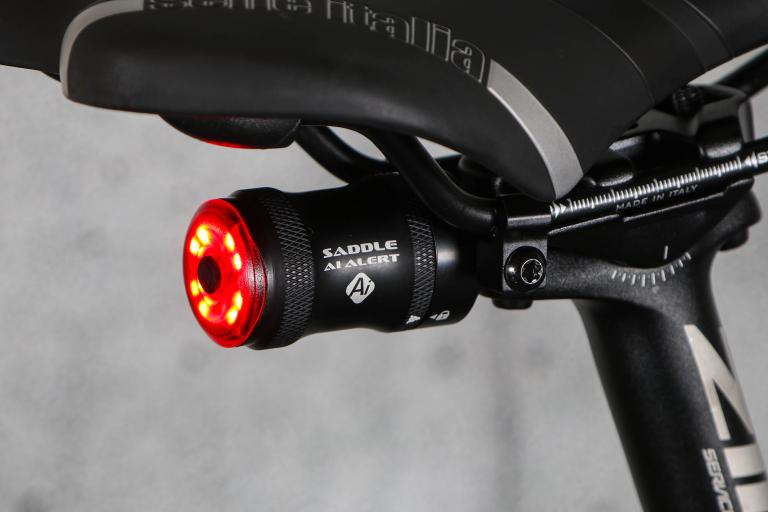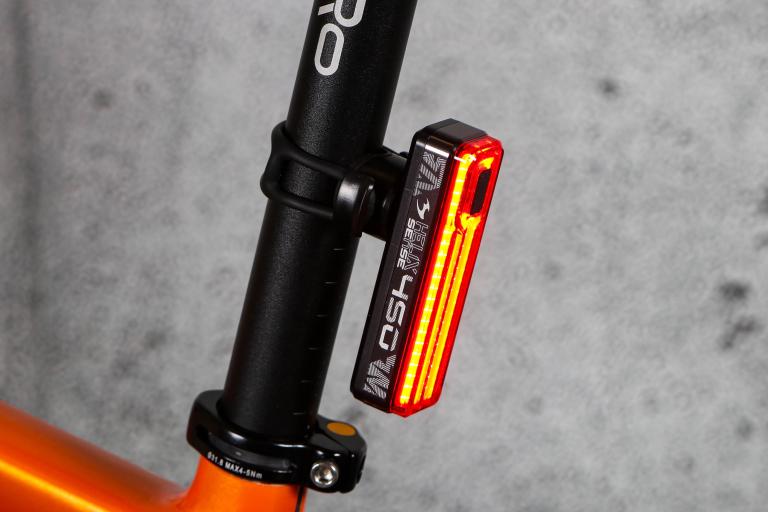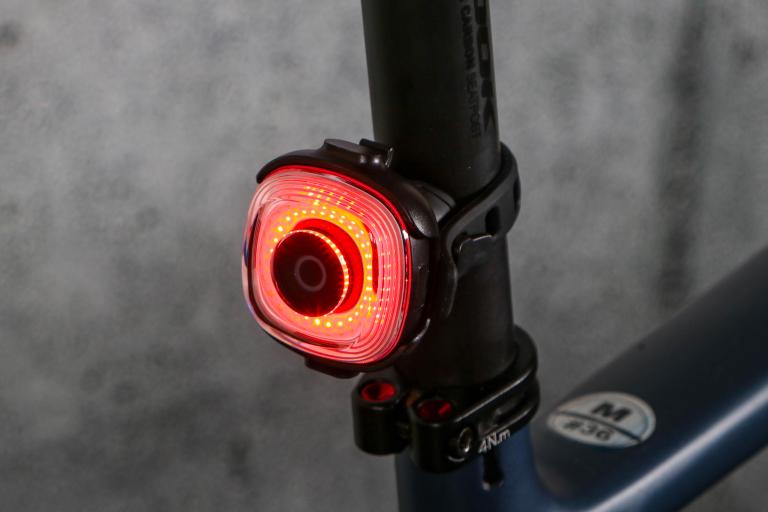- News
- Reviews
- Bikes
- Components
- Bar tape & grips
- Bottom brackets
- Brake & gear cables
- Brake & STI levers
- Brake pads & spares
- Brakes
- Cassettes & freewheels
- Chains
- Chainsets & chainrings
- Derailleurs - front
- Derailleurs - rear
- Forks
- Gear levers & shifters
- Groupsets
- Handlebars & extensions
- Headsets
- Hubs
- Inner tubes
- Pedals
- Quick releases & skewers
- Saddles
- Seatposts
- Stems
- Wheels
- Tyres
- Tubeless valves
- Accessories
- Accessories - misc
- Computer mounts
- Bags
- Bar ends
- Bike bags & cases
- Bottle cages
- Bottles
- Cameras
- Car racks
- Child seats
- Computers
- Glasses
- GPS units
- Helmets
- Lights - front
- Lights - rear
- Lights - sets
- Locks
- Mirrors
- Mudguards
- Racks
- Pumps & CO2 inflators
- Puncture kits
- Reflectives
- Smart watches
- Stands and racks
- Trailers
- Clothing
- Health, fitness and nutrition
- Tools and workshop
- Miscellaneous
- Buyers Guides
- Features
- Forum
- Recommends
- Podcast
review
 2020 Knog Plug Rear Light
2020 Knog Plug Rear Light£21.99
VERDICT:
Simple but effective rear light with good battery life for the price
Simple to use
Good battery life
Weight:
32g
Contact:
At road.cc every product is thoroughly tested for as long as it takes to get a proper insight into how well it works. Our reviewers are experienced cyclists that we trust to be objective. While we strive to ensure that opinions expressed are backed up by facts, reviews are by their nature an informed opinion, not a definitive verdict. We don't intentionally try to break anything (except locks) but we do try to look for weak points in any design. The overall score is not just an average of the other scores: it reflects both a product's function and value – with value determined by how a product compares with items of similar spec, quality, and price.
What the road.cc scores meanGood scores are more common than bad, because fortunately good products are more common than bad.
- Exceptional
- Excellent
- Very Good
- Good
- Quite good
- Average
- Not so good
- Poor
- Bad
- Appalling
The Knog Plug is a simple and effective rear light, offering a decent selection of modes, good battery life for its price point, and ease of use.
Over the years I have used several Knog lights and generally been impressed with them. The Plug is essentially a stripped-back, everyday light, that is cheap but effective.
> Find your nearest dealer here
It uses a single LED that pumps out 10 lumens, which isn't the brightest but is more than enough for most uses. I found that motorists and other cyclists could easily see me regardless of what else was around at night. I would want something a little more substantial for daytime use, though.
To operate, the light has a single large button on the top which you press and hold to either turn on or off, then press to cycle through the five modes. These are Max, Pulse, Flash, Random and Eco Flash.
The longest run-time is, no surprise, Eco Flash, which Knog says has a run-time over 100 hours; the shortest, Max, is 3 hours. I generally tended to use the middle, Flash, mode which offered enough visibility to feel safe combined with 20 hours' run-time.
I found these quoted run-times were broadly accurate, and for a sub £25 light they're very good.
Charging takes around 2.5 hours from a mains socket, around 30 minutes longer through a computer. Charging is done through a micro USB socket hidden behind a silicone dust cap which also acts as part of the mount. This isn't quite as neat as other Knog lights I've used, which have a USB built in to the light, but it's no biggie. You can also see when the light needs charging thanks to an LED indicator in the lens, which is useful.
Mounting the light is done simply with a rubber band that wraps around the seatpost and connects to hooks on the body of the light; the V-shaped silicone dust cover at the rear sits against the post, keeping it in place. The back of the Plug is angled, which helps it point at the right angle on most seatposts.
I used the Plug in a variety of conditions, including torrential downpours, and at no point did any water get in or was there any impact on its performance.
> Buyer’s Guide: 18 of the best rear lights for cycling
Its rrp of £21.99 is on a par with lights of similar size and output: the Vel 20 Lumen Rear Light comes in at £20, with 30 lumens but shorter run-times, while the Bookman Block is £20, though lighter and slightly more powerful (18 lumens).
Overall I was impressed by this little light. It isn't as powerful or gadget-packed as some, but it's simple, offers enough light to be seen, is protected against the weather, and doesn't break the bank.
Verdict
Simple but effective rear light with good battery life for the price
road.cc test report
Make and model: Knog Plug Rear Light
Size tested: 10 lumen
Tell us what the light is for, and who it's aimed at. What do the manufacturers say about it? How does that compare to your own feelings about it?
Knog says, 'This is a light for every-day, for every ride, for everybody.'
Tell us some more about the technical aspects of the light?
Knog lists:
Dimensions
H: 40mm x W: 33mm x L:50mm
Weight
30 grams
Charge Time
2.5 hours
Lumens
10
Rate the light for quality of construction:
7/10
It's waterproof, and the slightly rubberised material means it is likely to survive a fall.
Rate the light for design and ease of use. How simple was the light to use?
9/10
It could not be easier – one button to use it, one strap to attach it. Simple but effective.
Rate the light for the design and usability of the clamping system/s
9/10
You get three bands that come with the light for all seatpost sizes; once on, it holds the light in position well.
Rate the light for waterproofing. How did it stand up to the elements?
8/10
No problem at all, I used this is very wet conditions without any problems.
Rate the light for battery life. How long did it last? How long did it take to recharge?
8/10
Battery life is very good for a £22 light.
Rate the light for performance:
7/10
It's not the most powerful, but good for the price, as is battery life.
Rate the light for durability:
8/10
Early days, but it's stood up to rain and dirt, and there is no reason to think it won't last a long time.
Rate the light for weight:
7/10
Coming in at 32g means it's not the lightest on the scales, but is hardly going to hinder you.
Rate the light for value:
5/10
Around the same price as others, and the long battery life makes it more attractive than some cheaper options.
Tell us how the light performed overall when used for its designed purpose
It's powerful enough to make sure you're seen, without blinding anyone. Its long battery life means it works well as a backup light too.
Tell us what you particularly liked about the light
Good battery life.
Tell us what you particularly disliked about the light
It'd be nice to have the USB built in, like other Knog lights.
How does the price compare to that of similar products in the market, including ones recently tested on road.cc?
The Bookman Block is £20, lighter and slightly more powerful; the Vel 20 Lumen Rear Light is also £20, with 30 lumens but shorter run-times.
Did you enjoy using the light? Yes
Would you consider buying the light? Yes
Would you recommend the light to a friend? Yes
Use this box to explain your overall score
It's a pared-back but effective rear light; it's not the brightest but there's appeal in its simplicity. Its battery life is also good, especially compared to others in the same price range.
About the tester
Age: 32
I usually ride: CAAD13 My best bike is: Cannondale Supersix Evo
I've been riding for: 5-10 years I ride: Every day I would class myself as: Expert
I regularly do the following types of riding: commuting, club rides, sportives, general fitness riding, fixed/singlespeed, mtb,
George is the host of the road.cc podcast and has been writing for road.cc since 2014. He has reviewed everything from a saddle with a shark fin through to a set of glasses with a HUD and everything in between.
Although, ironically, spending more time writing and talking about cycling than on the bike nowadays, he still manages to do a couple of decent rides every week on his ever changing number of bikes.
Latest Comments
- dh700 1 sec ago
First off, let me say that I recognize and appreciate that you are willing and able to have a discussion on this topic -- unlike a couple other...
- Geoff H 1 hour 20 min ago
None of the commenters below noted that NONE of the car pictured are going to "back out quickly"! Are those bollards solid steel posts? Or are they...
- ChrisA 5 hours 49 min ago
Just seems like a general lack of consideration; less regard for (what were) social norms - everything from rubbish to rubbish driving....
- Jakrayan 6 hours 1 min ago
By the same token, if you were a doctor working in the A&E department of a London hospital, what would you say to the parent of a child...
- dh700 6 hours 6 min ago
Not with the materials that are used in bicycle construction. In order to make a double-triangle frame vertically flexible during use as a bicycle...
- mdavidford 6 hours 27 min ago
This is going to give cross people something else to hang their crossness on.
- Rendel Harris 6 hours 48 min ago
You are Marcus Wallmeyer and I claim my €5.
- RedJohn 7 hours 30 min ago
You're kidding, they've reinvented toe clips and straps 🤣
- David9694 7 hours 53 min ago
Drivers will no doubt be working their way through their usual set of excuses why there can't be a 20 mph limit, but why - in the absence of any...
- Spangly Shiny 8 hours 36 min ago
Was never on the CW forum, but now that the BikeRadar forum has folded there may just be a few inflatables migrating from there in the near future.




Add new comment
2 comments
Why do manufacturers insist on making rechargeable units like this? Once the battery dies the whole thing gets binned, I'd be surprised if small items like this were ever recycled. I've a pair of Lezyne front & rear lights which have been running brightly off of a series of CR2032s for years & at least I can recycle the batteries. My brother's gone through several 'rechargeable' units in the same time; the waste just makes no sense.
For larger, more powerful than this, perhaps, then rechargeable batteries do make sense, they would be burning through replaceable batteries at a massive rate. It is also easier to recharge the unit than to change batteries.
I can also allow for a more compact unit, when batteries need to be changed, the almost the whole device needs to be taken apart, and then all of this needs to be sealed well enough so the unit is adequetely waterproofed. With the micro USB charging only the port or "thingy" needs to be protected, which, admittedly, is often a very weak point, and needs some work.
Whenever I used to run replaceable batteries, back in the day, I would never use rechargeable cells on the rear, they tend to die a bit too quick. You would notice it on the front. But now when I run multiple lights on the rear, I don't mind the quick fading of the light, because with non recargeable cells, that death is a long one and not always noticable to the user. I used to often see fellow riders with very weak rear flashers, which may have been bright enough when they turned it on, even just a few minutes ago, in the way that replaceable cells do.
My take on it all anyway.
And good CR2032 cells are proper pricey too...